Influence of Different Redevelopment Measures on Water–Oil Immiscible Displacement and Mechanism Analysis
Abstract
1. Introduction
2. Mathematical Model
3. Physical Model, Parameter, and Case Settings
3.1. Physical Model
3.2. Parameter and Boundary Settings
3.3. Case Settings
4. Results and Discussion
4.1. Instantaneous Oil–Water Dynamic Behaviors
4.1.1. Oil–Water Two-Phase Distribution
4.1.2. Fluid Velocity at the Monitoring Point
4.2. Oil–Water Dynamic Behaviors in a Steady State
4.2.1. Sweep
4.2.2. Recovery Factor
5. Conclusions
- (1)
- In the process of micro-pore media displacement, the forward movement of the oil–water interface in the throat and pores can lead to changes in the magnitude and direction of interfacial tension. This is the direct reason for the step migration of the oil–water interface or the change in displacement channels at different times.
- (2)
- A difference in the injection rate will lead to variations in the dominant effect of water flooding (the viscous effect or capillary effect) in porous media. This is also the direct reason why the recovery rate increases initially and then decreases as the injection rate increases.
- (3)
- Different measures can increase the swept area and recovery factor by increasing the fluid driving force in the pores, reducing the oil–water interfacial tension, changing the oil–water path, increasing the oil–water viscosity uniformity, etc. The recovery factor can be significantly relatively greatly increased by reducing the surface tension coefficient at medium and high injection rates (≥0.01 m/s) and by increasing the viscosity of water at a low injection rate (<0.01 m/s).
Author Contributions
Funding
Data Availability Statement
Conflicts of Interest
References
- Pinilla, A.; Asuaje, M.; Ratkovich, N. Experimental and computational advances on the study of viscous fingering: An umbrella review. Heliyon 2021, 7, 07614. [Google Scholar] [CrossRef] [PubMed]
- Imhoff, P.T.; Miller, C.T. Dissolution fingering during the solubilization of nonaqueous phase liquids in saturated porous media: 2. experimental observations. Water Resour. Res. 1996, 32, 1919–1928. [Google Scholar] [CrossRef]
- Rodriguez, D.; Goyeau, B. Numerical analysis of the pore-scale mechanisms controlling the efficiency of immiscible displacement of a pollutant phase by a shear-thinning fluid. Chem. Eng. Sci. 2022, 251, 117462. [Google Scholar] [CrossRef]
- Saraf, S.; Bera, A. A review on pore-scale modeling and CT scan technique to characterize the trapped carbon dioxide in impermeable reservoir rocks during sequestration. Renew. Sustain. Energy Rev. 2021, 144, 110986. [Google Scholar] [CrossRef]
- Yang, Y.; Cai, S.; Yao, J.; Zhong, J.; Zhang, K.; Song, W.; Zhang, L.; Sun, H.; Lisitsa, V. Pore-scale simulation of remaining oil distribution in 3D porous media affected by wettability and capillarity based on volume of fluid method. Int. J. Multiph. Flow 2021, 143, 103746. [Google Scholar] [CrossRef]
- Zakirov, T.R.; Khramchenkov, M.G. Pore-scale study of the anisotropic effect on immiscible displacement in porous media under different wetting conditions and capillary numbers. J. Pet. Sci. Eng. 2022, 208, 109484. [Google Scholar] [CrossRef]
- Zakirov, T.R.; Khramchenkov, M.G. Wettability effect on the invasion patterns during immiscible displacement in heterogeneous porous media under dynamic conditions: A numerical study. J. Pet. Sci. Eng. 2021, 206, 109049. [Google Scholar] [CrossRef]
- Maksim, L.; Geir, E.; Martin, F. Pore-scale dynamics for underground porous media hydrogen storage. Adv. Water Resour. 2022, 163, 104167. [Google Scholar]
- Wang, J.L.; Yang, Y.F.; Cai, S.B.; Yao, J.; Xie, Q. Pore-scale modelling on hydrogen transport in porous media: Implications for hydrogen storage in saline aquifers. Int. J. Hydrogen Energy 2023, 48, 13922–13933. [Google Scholar] [CrossRef]
- Ma, K.; Liontas, R.; Conn, C.A.; Hirasaki, G.J.; Biswal, S.L. Visualization of improved sweep with foam in heterogeneous porous media using microfluidics. Soft Matter 2012, 8, 10669–10675. [Google Scholar] [CrossRef]
- Mahdi, M.B.; Cyprien, S.; Mohamed, A.; Sophie, R. How interfacial dynamics controls drainage pore-invasion patterns in porous media. Adv. Water Resour. 2023, 171, 104353. [Google Scholar]
- Hu, Y.; Patmonoaji, A.; Zhang, C.; Suekane, T. Experimental study on the displacement patterns and the phase diagram of immiscible fluid displacement in three-dimensional porous media. Adv. Water Resour. 2020, 140, 103584. [Google Scholar] [CrossRef]
- Iyi, D.; Balogun, Y.; Oyeneyin, B.; Faisal, N. Numerical Modelling of the effect of wettability, interfacial tension and temperature on oil recovery at pore-scale level. J. Pet. Sci. Eng. 2021, 201, 108453. [Google Scholar] [CrossRef]
- Michels, R.; Siebert, D.N.; Santos, L. Investigation on the influence of capillary number on drainage in porous media using a lattice Boltzmann method. J. Pet. Sci. Eng. 2021, 205, 108918. [Google Scholar] [CrossRef]
- Lenormand, R.; Touboul, E.; Zarcone, C. Numerical models and experiments on immiscible displacements in porous media. J. Fluid Mech. 1988, 189, 165–187. [Google Scholar] [CrossRef]
- Patel, H.V.; Kuipers, J.; Peters, E. Effect of flow and fluid properties on the mobility of multiphase flows through porous media. Chem. Eng. Sci. 2019, 193, 243–254. [Google Scholar] [CrossRef]
- Tang, M.; Lu, S.F.; Zhan, H.B.; Guo, W.Q.; Ma, H.F. The effect of a microscale fracture on dynamic capillary pressure of two-phase flow in porous media. Adv. Water Resour. 2018, 113, 272–284. [Google Scholar] [CrossRef]
- Zhang, L.; Zhang, C.; Zhang, K.; Zhang, L.; Yao, J.; Sun, H.; Yang, Y. Pore-scale investigation of methane hydrate dissociation using the Lattice Boltzmann method. Water Resour. Res. 2019, 55, 8422–8444. [Google Scholar] [CrossRef]
- Zhao, J.; Yao, J.; Li, A.; Zhang, M.; Zhang, L.; Yang, Y.; Sun, H. Simulation of microscale gas flow in heterogeneous porous media based on the lattice Boltzmann method. J. Appl. Phys. 2016, 120, 084306. [Google Scholar] [CrossRef]
- Song, W.; Yao, J.; Ma, J.; Sun, H.; Li, Y.; Yang, Y.; Hai, S.; Yang, L.; Yang, Y.F.; Zhang, L. Numerical simulation of multiphase flow in nanoporous organic matter with application to coal and gas shale systems. Water Resour. Res. 2018, 54, 1077–1092. [Google Scholar] [CrossRef]
- Yang, Y.; Wang, K.; Zhang, L.; Sun, H.; Zhang, K.; Ma, J. Pore-scale simulation of shale oil flow based on pore network model. Fuel 2019, 251, 683–692. [Google Scholar] [CrossRef]
- Yang, Q.; Yao, J.; Huang, Z.; Zhu, G.; Liu, L.; Song, W. Pore-scale investigation of petro-physical fluid behaviours based on multiphase SPH method. J. Pet. Sci. Eng. 2020, 192, 107238. [Google Scholar] [CrossRef]
- Zhang, L.; Xu, C.; Guo, Y.; Zhu, G.; Cai, S.; Wang, X.; Jing, W.; Sun, H.; Yang, Y.; Yao, J. The effect of surface roughness on immiscible displacement using pore scale simulation. Transp. Porous Media 2021, 140, 713–725. [Google Scholar] [CrossRef]
- Peng, J.; Song, R.; Wang, Y.; Xiao, H. Comparative study of VOF, LS, and VOSET on pore-scale immiscible waterflooding modeling. Petroleum 2021, 7, 314–324. (In Chinese) [Google Scholar] [CrossRef]
- Ferrari, A.; Magnini, M.; Thome, J.R. A flexible coupled level set and volume of fluid (flexCLV) method to simulate microscale two-phase flow in non-uniform and unstructured meshes. Int. J. Multiph. Flow 2017, 91, 276–295. [Google Scholar] [CrossRef]
- de Castro, A.R.; Agnaou, M.; Gostick, J. Predicting shear-thinning fluid flows in porous media using pore network modeling: Simulations and experimental validation. Transp. Porous Media 2023. [Google Scholar] [CrossRef]
- Yu, H.S.; Leung, J.Y. Numerical pore-scale simulation of propane injection for heavy oil displacement processes. Int. J. Multiph. Flow 2023, 159, 104319. [Google Scholar] [CrossRef]
- Liu, H.; Valocchi, A.J.; Werth, C.; Kang, Q.; Oostrom, M. Pore-scale simulation of liquid CO2 displacement of water using a two-phase lattice Boltzmann model. Adv. Water Resour. 2014, 73, 144–158. [Google Scholar] [CrossRef]
- Liu, H.; Zhang, Y.; Valocchi, A.J. Lattice Boltzmann simulation of immiscible fluid displacement in porous media: Homogeneous versus heterogeneous pore network. Phys. Fluids 2015, 27, 052103. [Google Scholar] [CrossRef]
- Liu, H.; Valocchi, A.J.; Kang, Q.; Werth, C. Pore-scale simulations of gas displacing liquid in a homogeneous pore network using the lattice Boltzmann method. Transp. Porous Media 2013, 99, 555–580. [Google Scholar] [CrossRef]
- Hirt, C.W.; Nichols, B.D. Volume of fluid (VOF) method for the dynamics of free boundaries. J. Comput. Phys. 1981, 39, 201–225. [Google Scholar] [CrossRef]
- Yu, D.; Tang, L.; Chen, C. Three-dimensional numerical simulation of mud flow from a tailing dam failure across complex terrain. Nat. Hazards Earth Sys. Sci. 2020, 20, 727–741. [Google Scholar] [CrossRef]
- Hu, R.; Wan, J.M.; Kim, Y.K.; Tokunaga, T.K. Wettability effects on supercritical CO2–brine immiscible displacement during drainage: Pore-scale observation and 3D simulation. Int. J. Greenh. Gas Control 2017, 60, 129–139. [Google Scholar] [CrossRef]
- Sarris, E.; Gravanis, E. Flow regime analysis of the pressure build-up during CO2 injection in saturated porous rock formations. Energies 2019, 12, 2972. [Google Scholar] [CrossRef]
- Booshi, S.; Ketabdari, M.J. Modeling of solitary wave interaction with emerged porous breakwater using PLIC-VOF method. Ocean Eng. 2021, 241, 110041. [Google Scholar] [CrossRef]
- Feichtner, A.; Mackay, E.; Tabor, G.; Thies, P.R.; Johanning, L. Comparison of macro-scale porosity implementations for CFD modelling of wave interaction with thin porous structures. J. Mar. Sci. Eng. 2021, 9, 150. [Google Scholar] [CrossRef]
- Minakov, A.V.; Guzei, D.V.; Pryazhnikov, M.I.; Filimonov, S.A.; Voronenkova, Y.O. 3D pore-scale modeling of nanofluids-enhanced oil recovery. Pet. Explor. Dev. 2021, 48, 956–967. [Google Scholar] [CrossRef]
- O’Brien, A.; Afkhami, S.; Bussmann, M. Pore-scale direct numerical simulation of Haines jumps in a porous media model. Eur. Phys. J. Spec. Top 2020, 229, 1785–1798. [Google Scholar] [CrossRef]
- Ambekar, A.S.; Mattey, P.; Buwa, V.V. Pore-resolved two-phase flow in a pseudo-3D porous medium: Measurements and volume-of-fluid simulations. Chem. Eng. Sci. 2021, 230, 116128. [Google Scholar] [CrossRef]
- Armstrong, R.T.; Evseev, N.; Koroteev, D.; Berg, S. Modeling the velocity field during Haines jumps in porous media. Adv. Water Resour. 2015, 77, 57–68. [Google Scholar] [CrossRef]
- Zacharoudiou, I.; Boek, E.S. Capillary filling and Haines jump dynamics using free energy Lattice Boltzmann simulations. Adv. Water Resour. 2016, 92, 43–56. [Google Scholar] [CrossRef]
- Timur, R.Z.; Maxim, G.K. Characterization of two-phase displacement mechanisms in porous media by capillary and viscous forces estimation using the lattice Boltzmann simulations. J. Pet. Sci. Eng. 2020, 184, 106575. [Google Scholar]


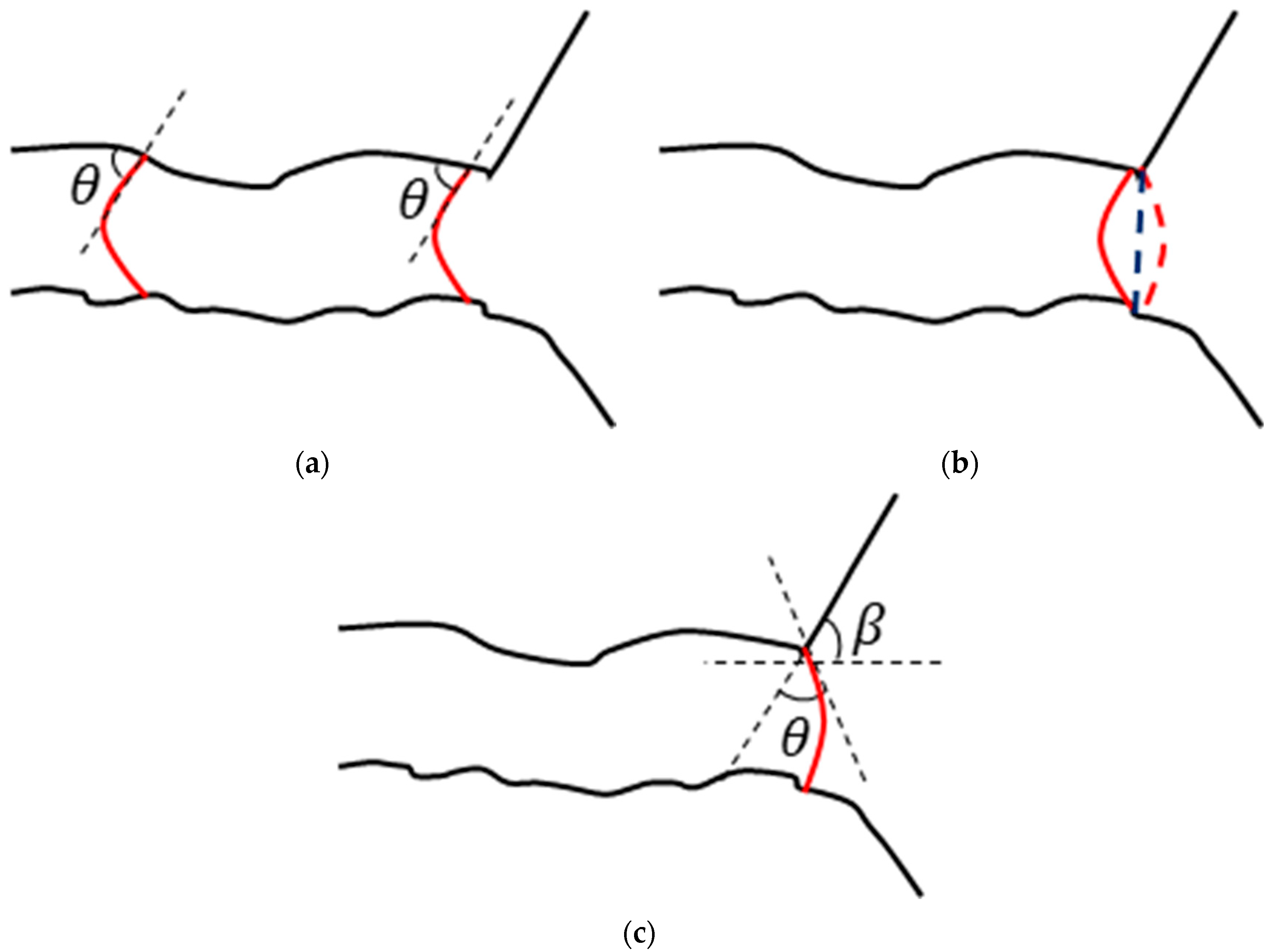
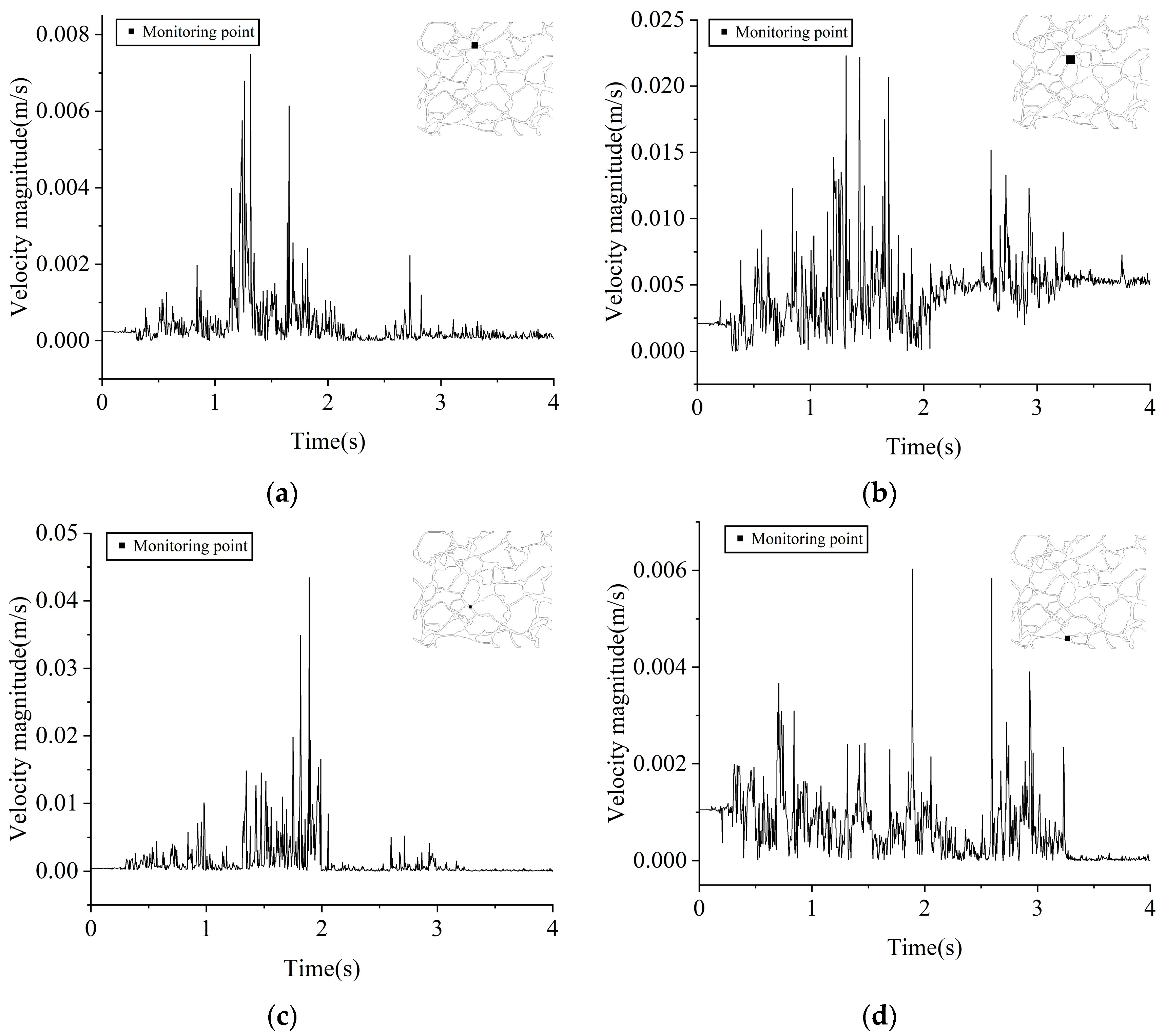


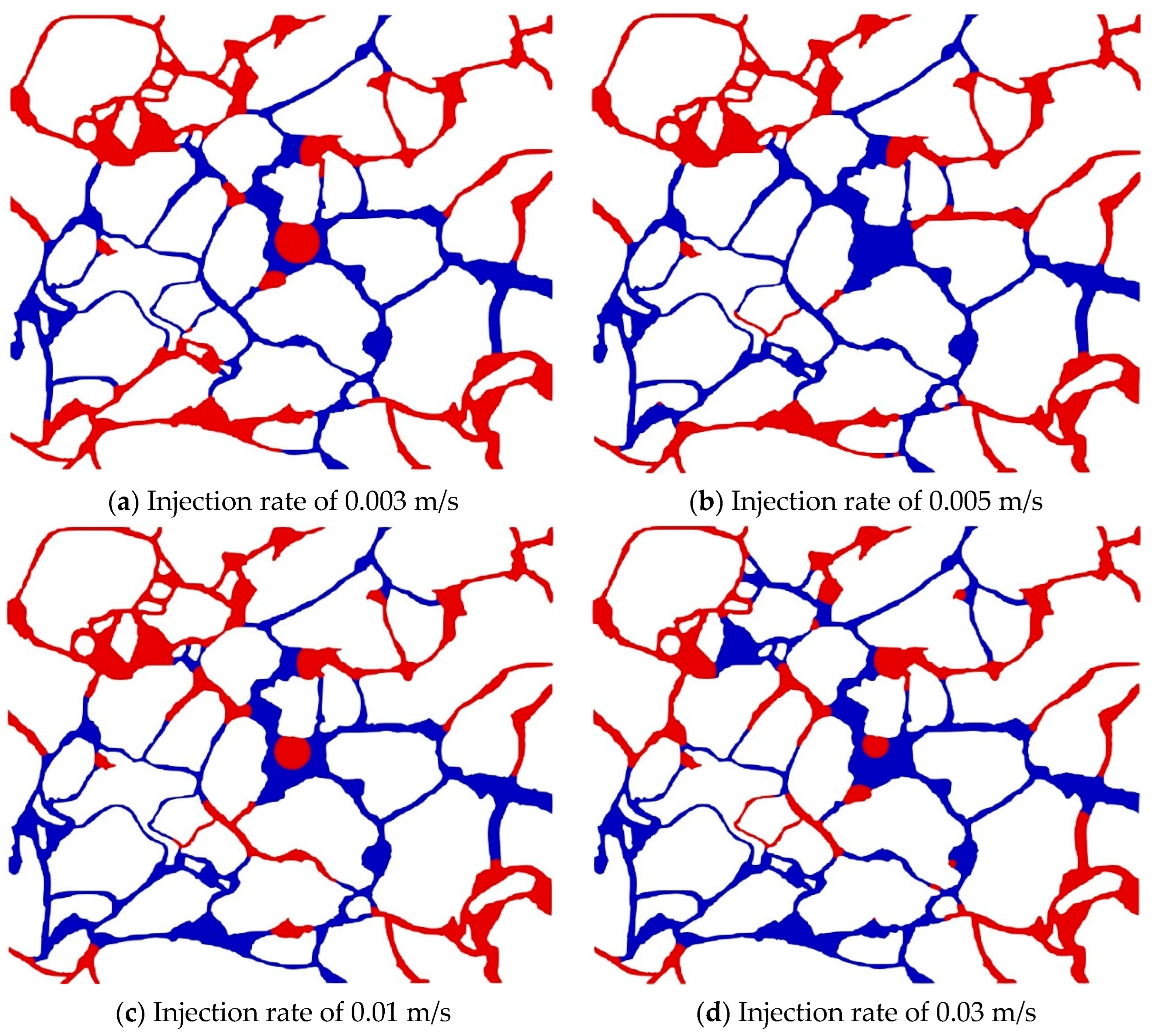
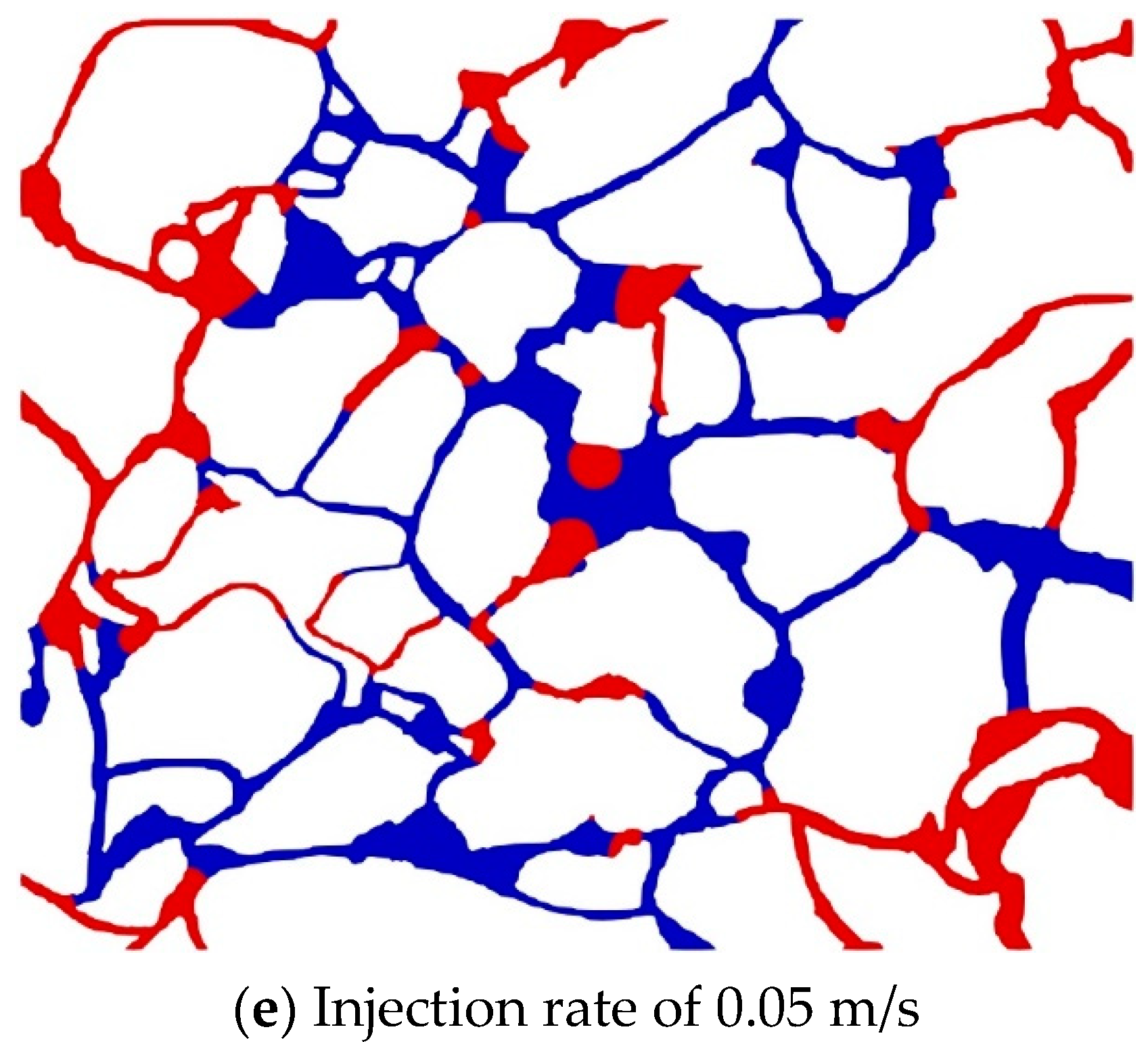
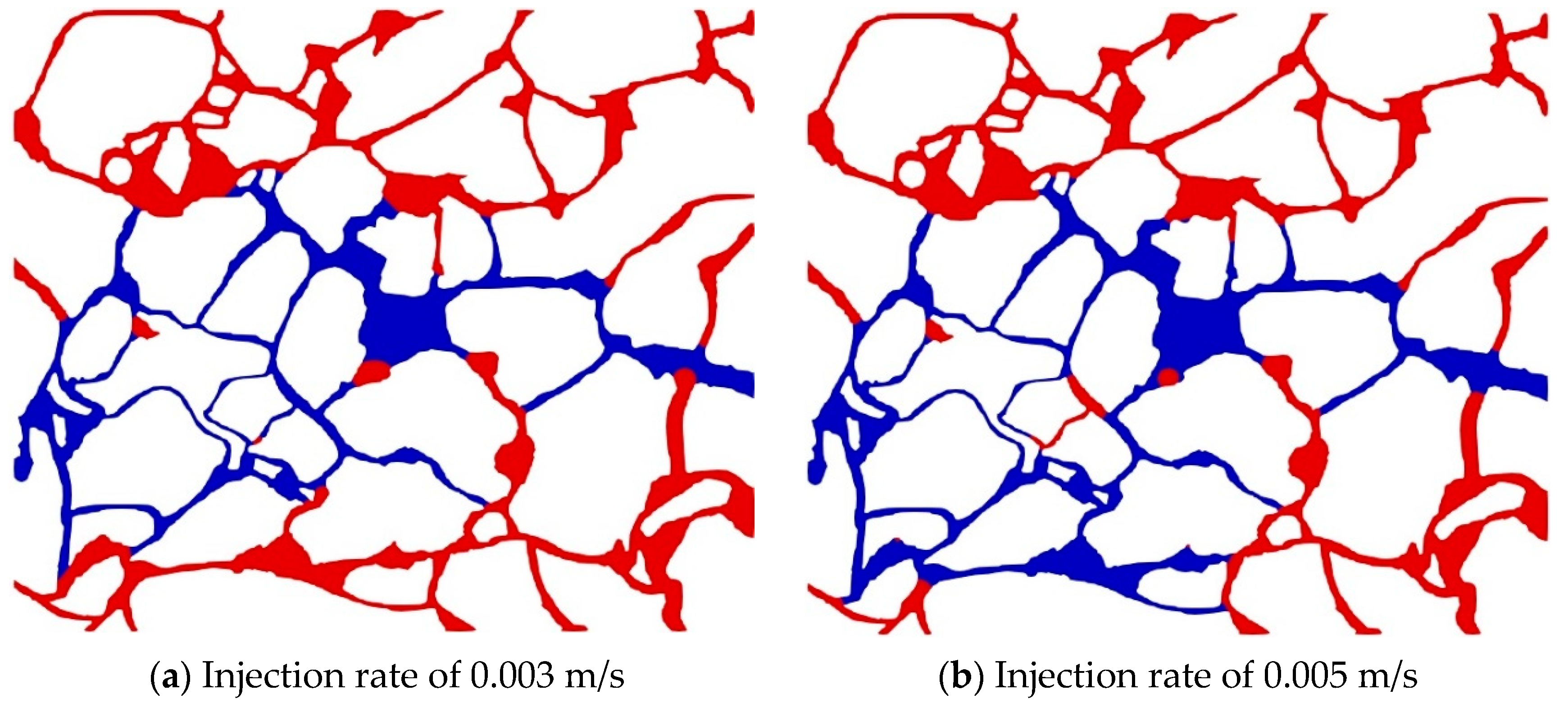
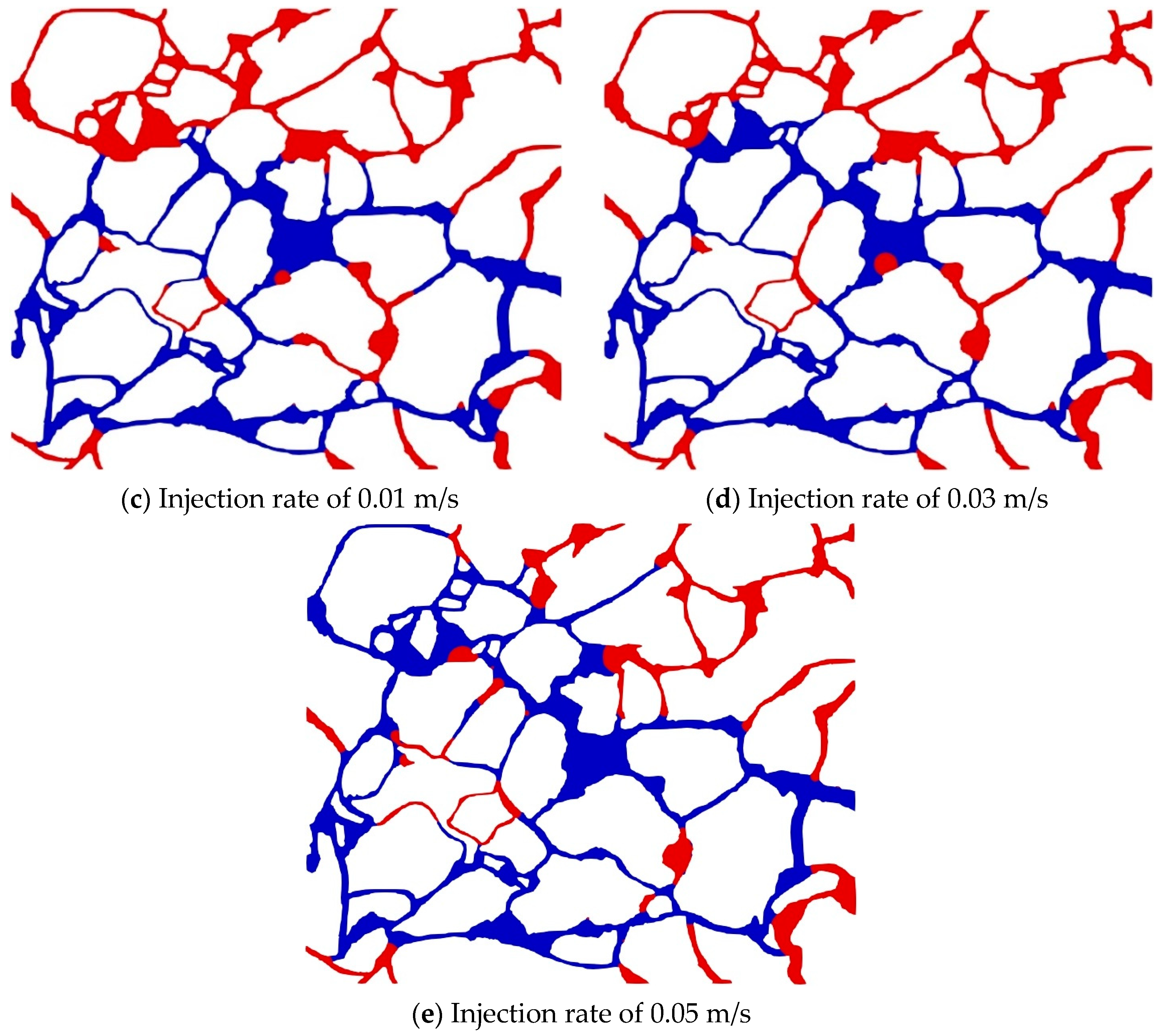
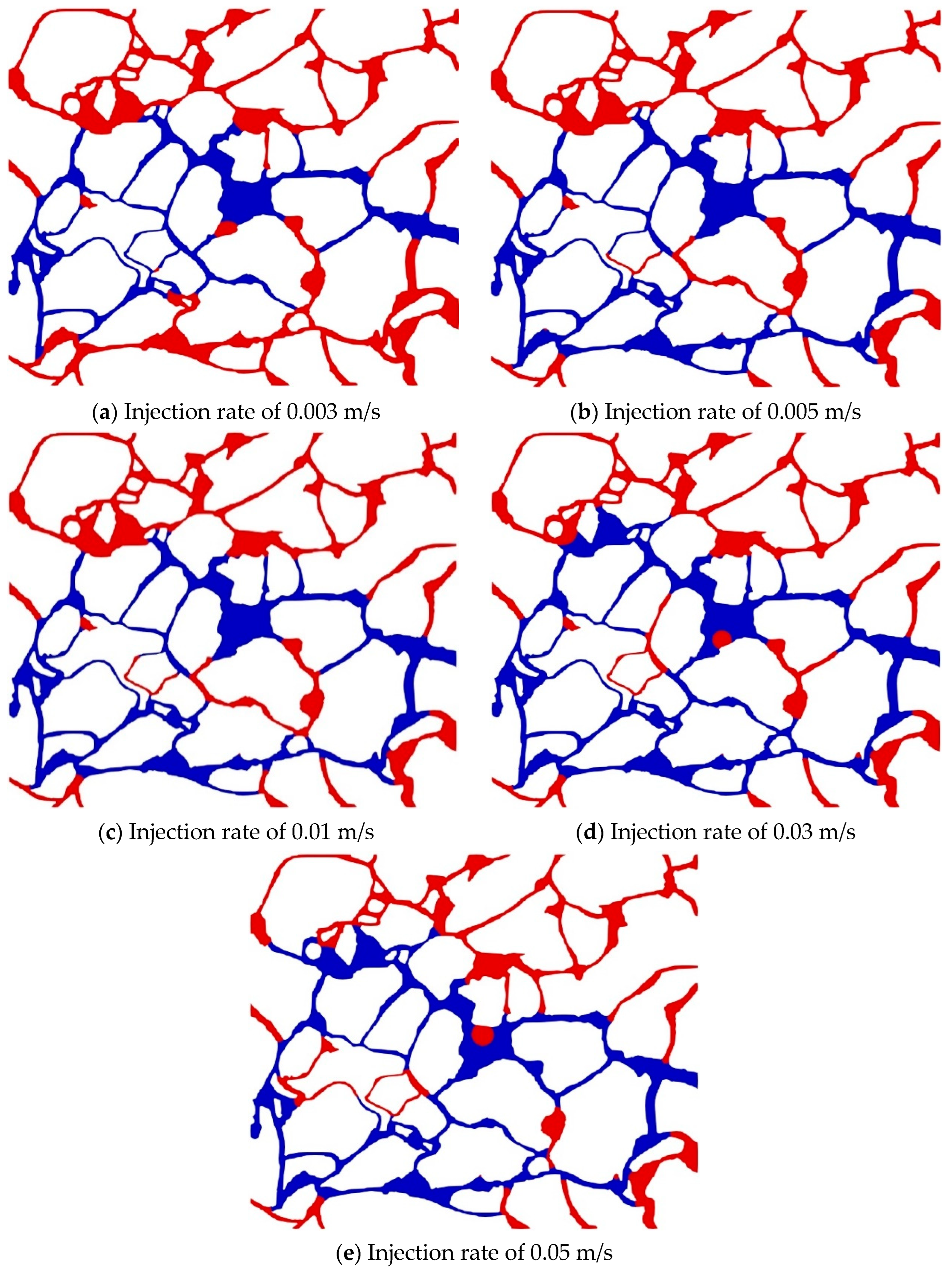

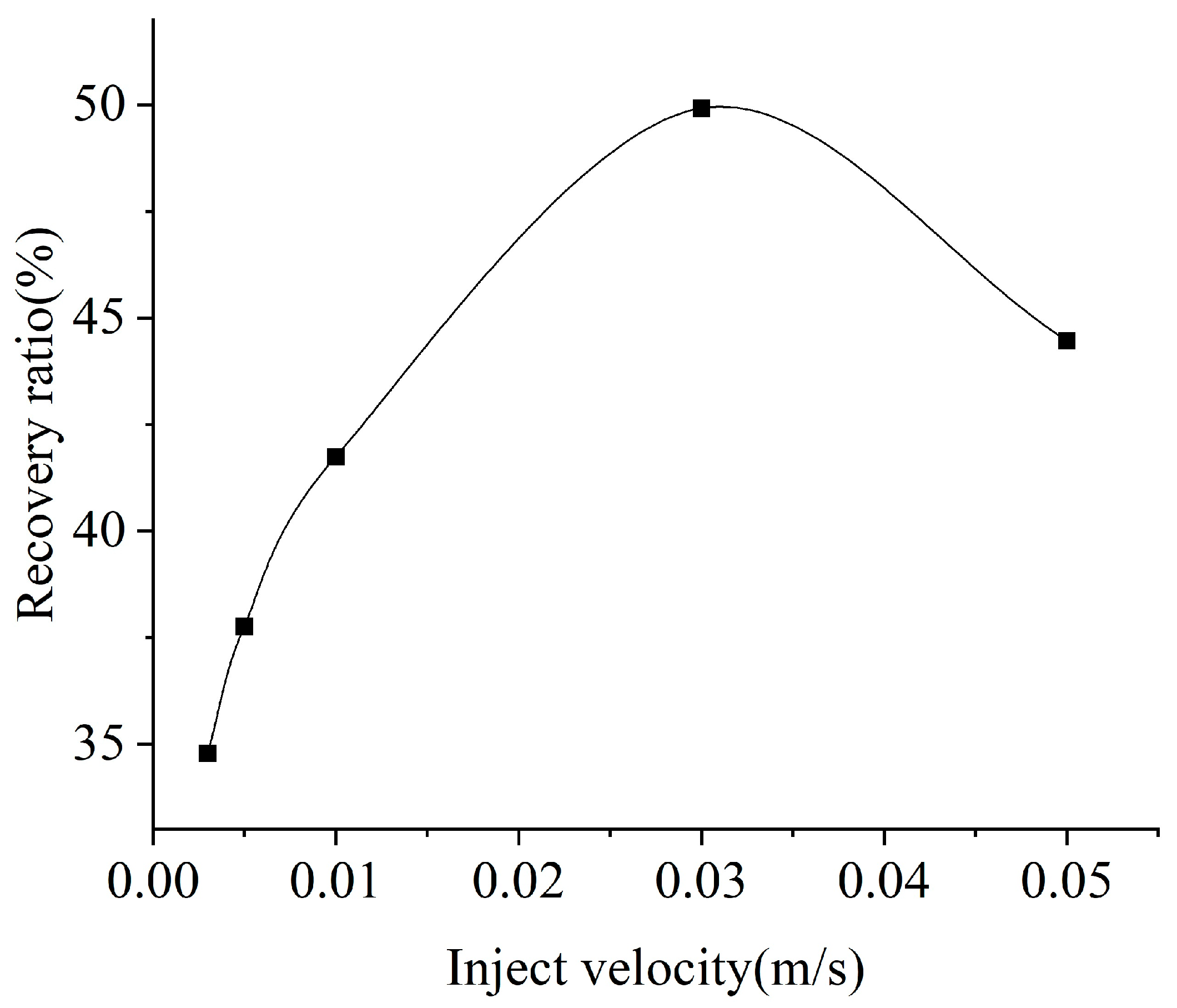
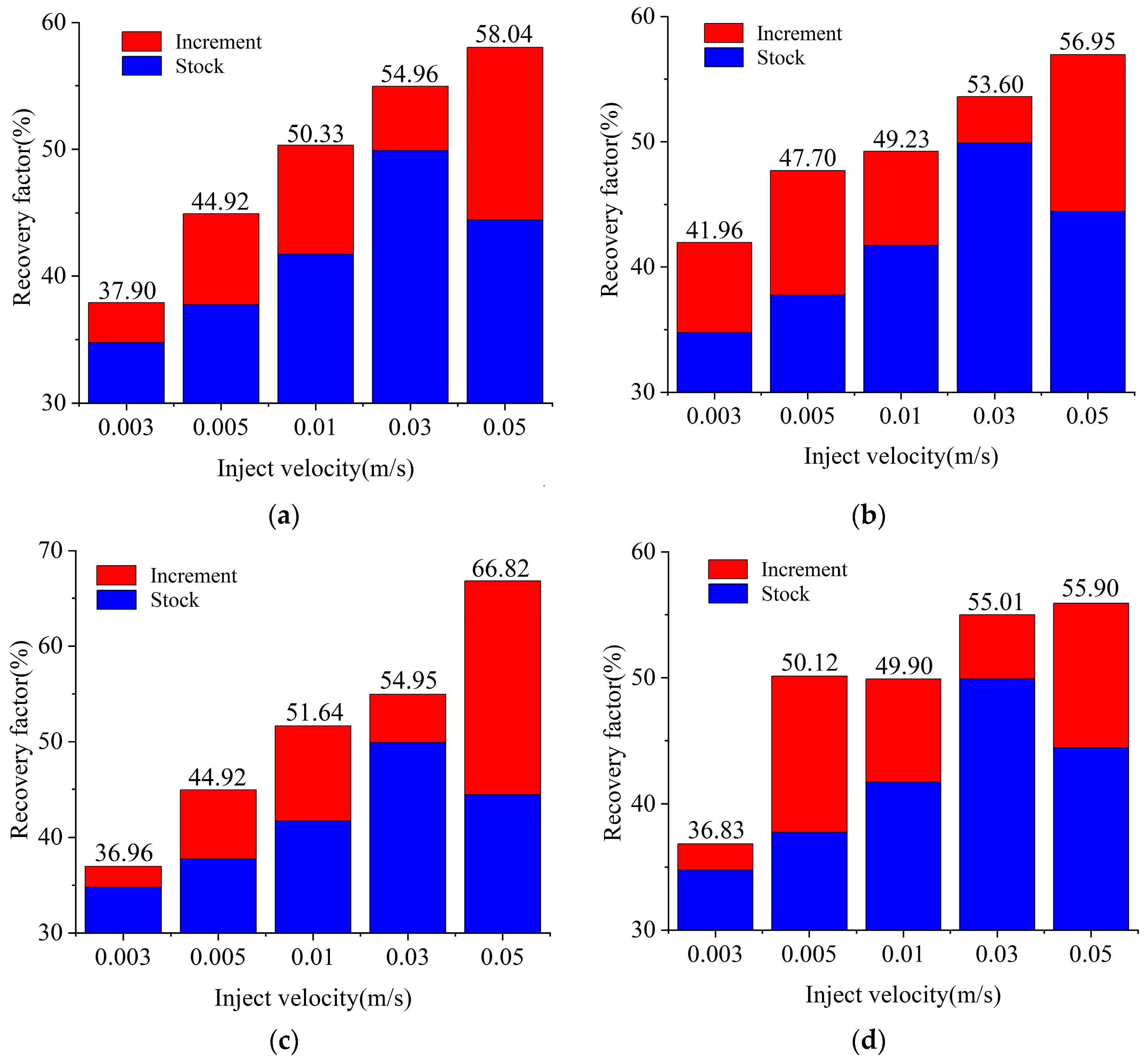
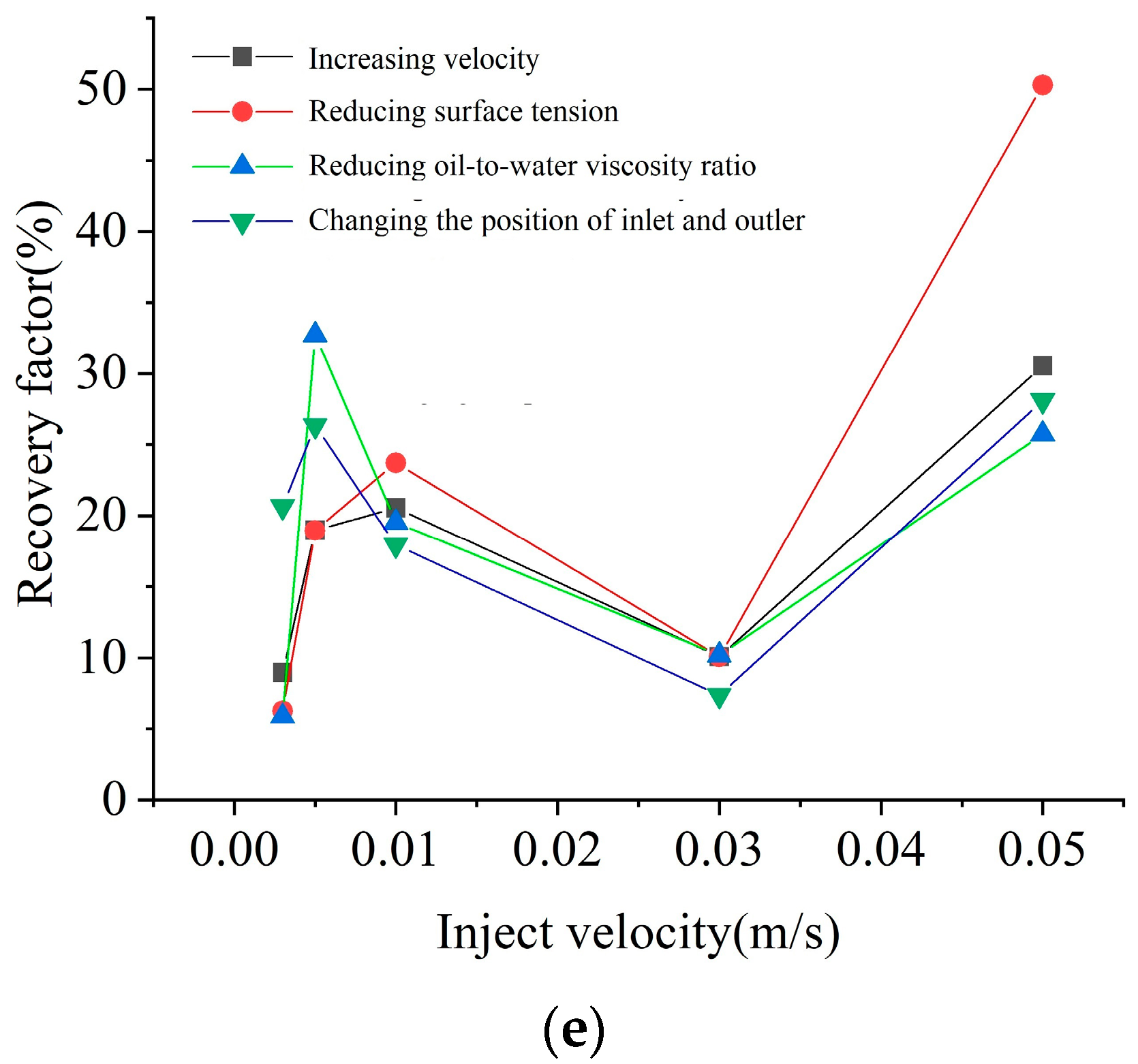
| Element Number | Point 1 Velocity (0.00057, 0.00199) | Point 2 Velocity (0.00207, 0.00164) | Point 3 Velocity (0.00324, 0.00157) |
|---|---|---|---|
| 57233 | 0.089 m/s | 0.0135 m/s | 0.0367 m/s |
| 105118 | 0.091 m/s | 0.0152 m/s | 0.0495 m/s |
| 203422 | 0.091 m/s | 0.0152 m/s | 0.0494 m/s |
| Physical Boundary | Physical Quantity | Numerical Boundary |
|---|---|---|
| Inlet | Velocity | fixedValue |
| Pressure | zeroGradient | |
| Alpha | fixedValue | |
| Outlet | Velocity | zeroGradient |
| Pressure | fixedValue | |
| Alpha | zeroGradient | |
| Walls | Velocity | fixedValue |
| Pressure | fixedFluxPressure | |
| Alpha | alphaContantAngle |
| No. | Injection Rate (m/s) | Increase Injection Rate (m/s) | Changing the Inlet/Outlet Position | Decrease Interfacial Tension Coefficient (kg/m−2) | Decrease the Viscosity Ratio of Oil to Water | Ca |
|---|---|---|---|---|---|---|
| 1 | 0.003 | No | No | No change (0.07) | No change (10:1) | 4.2 × 10−5 |
| 2 | 0.005 | No | No | No change (0.07) | No change (10:1) | 7.1 × 10−5 |
| 3 | 0.01 | No | No | No change (0.07) | No change (10:1) | 1.4 × 10−4 |
| 4 | 0.03 | No | No | No change (0.07) | No change (10:1) | 4.2 × 10−4 |
| 5 | 0.05 | No | No | No change (0.07) | No change (10:1) | 7.1 × 10−4 |
| 6 | 0.003 | 0.03 | No | No change (0.07) | No change (10:1) | 4.2 × 10−4 |
| 7 | 0.005 | 0.05 | No | No change (0.07) | No change (10:1) | 7.1 × 10−4 |
| 8 | 0.01 | 0.1 | No | No change (0.07) | No change (10:1) | 1.4 × 10−3 |
| 9 | 0.03 | 0.3 | No | No change (0.07) | No change (10:1) | 4.2 × 10−3 |
| 10 | 0.05 | 0.5 | No | No change (0.07) | No change (10:1) | 7.1 × 10−3 |
| 11 | 0.003 | No | Yes | No change (0.07) | No change (10:1) | 4.2 × 10−5 |
| 12 | 0.005 | No | Yes | No change (0.07) | No change (10:1) | 7.1 × 10−5 |
| 13 | 0.01 | No | Yes | No change (0.07) | No change (10:1) | 1.4 × 10−4 |
| 14 | 0.03 | No | Yes | No change (0.07) | No change (10:1) | 4.2 × 10−4 |
| 15 | 0.05 | No | Yes | No change (0.07) | No change (10:1) | 7.1 × 10−4 |
| 16 | 0.003 | No | No | 0.007 | No change (10:1) | 4.2 × 10−4 |
| 17 | 0.005 | No | No | 0.007 | No change (10:1) | 7.1 × 10−4 |
| 18 | 0.01 | No | No | 0.007 | No change (10:1) | 1.4 × 10−3 |
| 19 | 0.03 | No | No | 0.007 | No change (10:1) | 4.2 × 10−3 |
| 20 | 0.05 | No | No | 0.007 | No change (10:1) | 7.1 × 10−3 |
| 21 | 0.003 | No | No | No change (0.07) | 1:1 | 4.2 × 10−5 |
| 22 | 0.005 | No | No | No change (0.07) | 1:1 | 7.1 × 10−5 |
| 23 | 0.01 | No | No | No change (0.07) | 1:1 | 1.4 × 10−4 |
| 24 | 0.03 | No | No | No change (0.07) | 1:1 | 4.2 × 10−4 |
| 25 | 0.05 | No | No | No change (0.07) | 1:1 | 7.1 × 10−4 |
Disclaimer/Publisher’s Note: The statements, opinions and data contained in all publications are solely those of the individual author(s) and contributor(s) and not of MDPI and/or the editor(s). MDPI and/or the editor(s) disclaim responsibility for any injury to people or property resulting from any ideas, methods, instructions or products referred to in the content. |
© 2023 by the authors. Licensee MDPI, Basel, Switzerland. This article is an open access article distributed under the terms and conditions of the Creative Commons Attribution (CC BY) license (https://creativecommons.org/licenses/by/4.0/).
Share and Cite
Wang, L.; Wu, H.; Cao, Z.; Fang, S.; Duan, S.; Wang, Y. Influence of Different Redevelopment Measures on Water–Oil Immiscible Displacement and Mechanism Analysis. Energies 2023, 16, 5047. https://doi.org/10.3390/en16135047
Wang L, Wu H, Cao Z, Fang S, Duan S, Wang Y. Influence of Different Redevelopment Measures on Water–Oil Immiscible Displacement and Mechanism Analysis. Energies. 2023; 16(13):5047. https://doi.org/10.3390/en16135047
Chicago/Turabian StyleWang, Le, Haowen Wu, Zhourong Cao, Shijie Fang, Shiyu Duan, and Yishuo Wang. 2023. "Influence of Different Redevelopment Measures on Water–Oil Immiscible Displacement and Mechanism Analysis" Energies 16, no. 13: 5047. https://doi.org/10.3390/en16135047
APA StyleWang, L., Wu, H., Cao, Z., Fang, S., Duan, S., & Wang, Y. (2023). Influence of Different Redevelopment Measures on Water–Oil Immiscible Displacement and Mechanism Analysis. Energies, 16(13), 5047. https://doi.org/10.3390/en16135047





